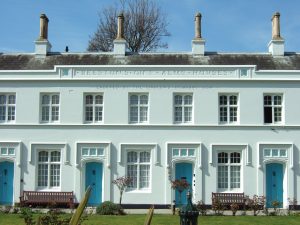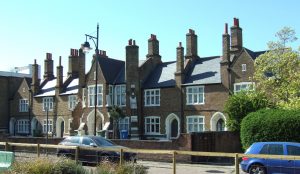Peckham and its environs have a disproportionate share of the capital’s remaining almshouses. The book, The Almshouses of London by Clive Berridge (1987), lists some fifty in the metropolis. Peckham has six of these. Moreover, one is London’s largest. All date from the first half of the nineteenth century. A brief description of our often unremarked architectural assets seems appropriate.
Licensed Victuallers Asylum, Asylum Road
This is one of the most striking and surprising buildings of any sort in Peckham. London’s largest almshouses are barely noticed from the road in summer. A few yards from the constant hum of the Old Kent Road they contrive – appropriately enough – to be off the beaten track.
The first stone was laid in 1828 and a series of additions were made later keeping to the original plain classical style, so that by 1875 Blanch, the local chronicler, could record that the “Asylum now consists of 170 separate and distinct habitations, and 205 inmates are provided with shelter, pecuniary assistance, coals, medicine and medical advice.”
The large ornamental gateway was added in 1927. The chapel with strong portico and lantern which forms the centrepiece of the building is in a sad state of decay. The residents of Caroline Gardens, as it is known today, are Council tenants, the retired victuallers having moved out to Denham.
Palyn’s Almshouses, Choumert Road
Palyn’s Almshouses represent a complete contrast, firstly in scale – there are but six dwellings in all “for the relief and sustentation of six poor men”. Secondly in the nature of the foundation – George Palyn was a wealthy member of the Girdlers’ Company and the almshouses were a personal bequest. Thirdly, these are replacement almshouses. Palyn’s originals of 1609 were in Pesthouse Row in the City of London. They became dilapidated and rather than rebuild on the site, the opportunity of a gift of freehold land off Rye Lane was taken and the present range of buildings erected.
They appear to be privately owned today.
Beeston’s Gift Almshouses, Consort Road near Nunhead Lane
These have a similar history to Palyn’s. Beeston, too, was a member of the Girdlers’ Company and in 1582 he gave property to the Company, the profits from which were to be distributed to the poor. The compulsory sale of this property to allow the building of approaches to a new London Bridge (in the 1820s) prompted the erection of this Tudor-style range in 1834. These are the quaintest and prettiest almshouses in the area, set back from the road, fronted by an attractive garden, complete with water pump.
The Metropolitan Beer and Wine Trade Society’s Asylum, Nunhead Green
The asylum enjoys an attractive setting on the north side of the green. Erected in 1853, these were the last almshouses to be built in the area.
The Female Friendly Asylum, Chumleigh Street between Albany Road and Neate Street (SE5)
The buildings now serve a useful role in Burgess Park, housing Council offices and changing rooms. In the mid 1980s the place was squatted and in disrepair. It is a simple U-shaped plan with two-storeyed terraces of plain brick around a central green. The gothic window mullions add a whimsical touch and the inscription is equally charming:
THE FRIENDLY FEMALE ASYLUM
FOR AGED PERSONS
WHO HAVE SEEN BETTER DAYS
ERECTED AND SUPPORTED
BY VOLUNTARY CONTRIBUTIONS
1821
Bethel Asylum
The final almshouse in Havil Street (SE5) is a plain construction dating from 1838, established to accommodate twelve aged women.
Why should so many almshouses be concentrated in the Peckham area? That is a question yet to be resolved.
Tim Charlesworth
Reprinted from Peckham Society News, Issue 43 (Spring 1991)


